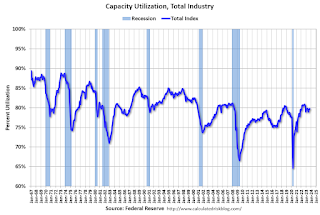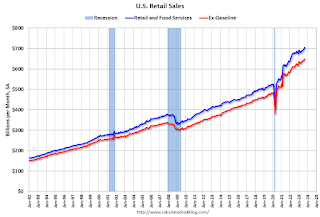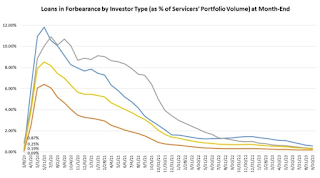by Calculated Risk on 10/17/2023 10:00:00 AM
Tuesday, October 17, 2023
NAHB: Builder Confidence Decreased in October
The National Association of Home Builders (NAHB) reported the housing market index (HMI) was at 40, down from 44 last month. Any number below 50 indicates that more builders view sales conditions as poor than good.
From the NAHB: Mortgage Rates Well Above 7% Continue to Hammer Builder Confidence
Stubbornly high mortgage rates that have climbed to a 23-year high and have remained above 7% for the past two months continue to take a heavy toll on builder confidence, as sentiment levels have dropped to the lowest point since January 2023.
Builder confidence in the market for newly built single-family homes in October fell four points to 40 from a downwardly revised September reading, according to the National Association of Home Builders (NAHB)/Wells Fargo Housing Market Index (HMI) released today. This is the third consecutive monthly drop in builder confidence.
“Builders have reported lower levels of buyer traffic, as some buyers, particularly younger ones, are priced out of the market because of higher interest rates,” said NAHB Chairman Alicia Huey, a custom home builder and developer from Birmingham, Ala. “Higher rates are also increasing the cost and availability of builder development and construction loans, which harms supply and contributes to lower housing affordability.”
Since late September, mortgage rates are up nearly 40 basis points to 7.57%, according to Freddie Mac. Interest rates have increased on the Federal Reserve’s apparent higher-for-longer monetary policy stance, better than expected macro growth during the third quarter and longer-term concerns over government budget deficits.
“The housing affordability crisis can only be solved by adding additional attainable, affordable supply,” said NAHB Chief Economist Robert Dietz. “Boosting housing production would help reduce the shelter inflation component that was responsible for more than half of the overall Consumer Price Index increase in September and aid the Fed’s mission to bring inflation back down to 2%. However, uncertainty regarding monetary policy is contributing to affordability challenges in the market.”
As a result of the extended high interest environment, many builders continue to reduce home prices to boost sales. In October, 32% of builders reported cutting home prices, unchanged from the previous month but still the highest rate since December 2022 (35%). The average price discount remains at 6%. Meanwhile, 62% of builders provided sales incentives of all forms in October, up from 59% in September and tied with the previous high for this cycle set in December 2022.
...
All three major HMI indices posted declines in October. The HMI index gauging current sales conditions fell four points to 46, the component charting sales expectations in the next six months dropped five points to 44 and the gauge measuring traffic of prospective buyers dipped four points to 26.
Looking at the three-month moving averages for regional HMI scores, the Northeast fell four points to 50, the Midwest dropped three points to 39, the South fell five points to 49 and the West posted a six-point decline to 41.
emphasis added
 Click on graph for larger image.
Click on graph for larger image.This graph shows the NAHB index since Jan 1985.
This was well below the consensus forecast.
Industrial Production Increased 0.3% in September
by Calculated Risk on 10/17/2023 09:15:00 AM
From the Fed: Industrial Production and Capacity Utilization
Industrial production increased 0.3 percent in September and advanced at an annual rate of 2.5 percent in the third quarter. Manufacturing output rose 0.4 percent in September, the index for mining moved up 0.4 percent, and the index for utilities decreased 0.3 percent. At 103.6 percent of its 2017 average, total industrial production in September was 0.1 percent above its year-earlier level. Capacity utilization moved up 0.2 percentage point to 79.7 percent in September, a rate that is equal to its long-run (1972–2022) average.
emphasis added
 Click on graph for larger image.
Click on graph for larger image.This graph shows Capacity Utilization. This series is up from the record low set in April 2020, and above the level in February 2020 (pre-pandemic).
Capacity utilization at 79.7% is at the average from 1972 to 2022. This was above consensus expectations.
Note: y-axis doesn't start at zero to better show the change.
 The second graph shows industrial production since 1967.
The second graph shows industrial production since 1967.Industrial production increased in August to 103.6. This is above the pre-pandemic level.
Industrial production was above consensus expectations, however the previous month was revised down.
Retail Sales Increased 0.7% in September
by Calculated Risk on 10/17/2023 08:30:00 AM
On a monthly basis, retail sales were up 0.7% from August to September (seasonally adjusted), and sales were up 3.8 percent from September 2022.
From the Census Bureau report:
Advance estimates of U.S. retail and food services sales for September 2023, adjusted for seasonal variation and holiday and trading-day differences, but not for price changes, were $704.9 billion, up 0.7 percent from the previous month, and up 3.8 percent above September 2022. ... The July 2023 to August 2023 percent change was revised from up 0.6 percent to up 0.8 percent (±0.1 percent).
emphasis added
 Click on graph for larger image.
Click on graph for larger image.This graph shows retail sales since 1992. This is monthly retail sales and food service, seasonally adjusted (total and ex-gasoline).
Retail sales ex-gasoline were up 0.7% in September.
The second graph shows the year-over-year change in retail sales and food service (ex-gasoline) since 1993.
Retail and Food service sales, ex-gasoline, increased by 4.3% on a YoY basis.
 The increase in sales in September was well above expectations, and sales in July and August were revised up.
The increase in sales in September was well above expectations, and sales in July and August were revised up.
Monday, October 16, 2023
Tuesday: Retail Sales, Industrial Production, Homebuilder Survey
by Calculated Risk on 10/16/2023 07:10:00 PM

Last week was mostly good for mortgage rates, even if the goodness was made possible in large part by the badness of the previous week. By Friday, rates were 0.15% lower than the previous Friday, on average.Tuesday:
As the new week begins, virtually all of that progress has been erased. In other words, the average lender is now very close to the same rates seen on Friday, October 6th. [30 year fixed 7.80%]
emphasis added
• At 8:30 AM ET, Retail sales for September will be released. The consensus is for a 0.2% increase in retail sales.
• At 9:15 AM, The Fed will release Industrial Production and Capacity Utilization for September. The consensus is for a 0.1% increase in Industrial Production, and for Capacity Utilization to decrease to 79.6%.
• At 10:00 AM, The October NAHB homebuilder survey. The consensus is for a reading of 44, down from 45 in September. Any number below 50 indicates that more builders view sales conditions as poor than good.
MBA Survey: "Share of Mortgage Loans in Forbearance Decreases to 0.31% in September"
by Calculated Risk on 10/16/2023 04:07:00 PM
From the MBA: Share of Mortgage Loans in Forbearance Decreases to 0.31% in September
The Mortgage Bankers Association’s (MBA) monthly Loan Monitoring Survey revealed that the total number of loans now in forbearance decreased by 2 basis points from 0.33% of servicers’ portfolio volume in the prior month to 0.31% as of September 30, 2023. According to MBA’s estimate, 155,000 homeowners are in forbearance plans. Mortgage servicers have provided forbearance to approximately 8 million borrowers since March 2020.
In September 2023, the share of Fannie Mae and Freddie Mac loans in forbearance decreased 1 basis point to 0.18%. Ginnie Mae loans in forbearance decreased 8 basis points to 0.57%, and the forbearance share for portfolio loans and private-label securities (PLS) decreased 4 basis points to 0.35%.
“The number of loans in forbearance dropped in September, but the overall performance of servicing portfolios and loan workouts declined slightly,” said Marina Walsh, CMB, MBA’s Vice President of Industry Analysis. “MBA’s baseline forecast has a recession in the first half of 2024. Several factors – including unemployment increases, rising property taxes and insurance, the resumption of student debt payments, and possible natural disasters – may affect loan performance in future months.”
emphasis added
 Click on graph for larger image.
Click on graph for larger image.This graph shows the percent of portfolio in forbearance by investor type over time.
The share of forbearance plans has been decreasing and declined to 0.31% in September from 0.33% in August.
At the end of August, there were about 155,000 homeowners in forbearance plans.
Preliminary 2024 Housing Forecasts
by Calculated Risk on 10/16/2023 10:51:00 AM
Today, in the Calculated Risk Real Estate Newsletter: Preliminary 2024 Housing Forecasts
A brief excerpt:
Towards the end of each year, I collect some housing forecasts for the following year - and also provide my own outlook. Several more forecast will be available in early December.There is much more in the article. You can subscribe at https://calculatedrisk.substack.com/
...
A few key points from these early forecasts:
1) Forecasters expect house prices in increase next year.
2) Everyone expects multi-family starts to be down sharply in 2024.
3) 30-year fixed rate mortgages rates are expected to be above 6% next year (MBA is at 6.1%, NAHB is at 6.4%, and Fannie is at 6.9%)
I’ll have several more forecasts (and updated forecasts) by December.
Housing October 16th Weekly Update: Inventory increased 1.8% Week-over-week; Down 3.5% Year-over-year
by Calculated Risk on 10/16/2023 08:19:00 AM
 Click on graph for larger image.
Click on graph for larger image.This inventory graph is courtesy of Altos Research.

Sunday, October 15, 2023
Sunday Night Futures
by Calculated Risk on 10/15/2023 07:00:00 PM
Weekend:
• Schedule for Week of October 15, 2023
Monday:
• At 8:30 AM ET, The New York Fed Empire State manufacturing survey for October. The consensus is for a reading of -1.5, down from 1.9.
From CNBC: Pre-Market Data and Bloomberg futures S&P 500 futures are up 4 and DOW futures are up 27 (fair value).
Oil prices were up over the last week with WTI futures at $87.69 per barrel and Brent at $90.89 per barrel. A year ago, WTI was at $86, and Brent was at $92 - so WTI oil prices were up slightly year-over-year.
Here is a graph from Gasbuddy.com for nationwide gasoline prices. Nationally prices are at $3.56 per gallon. A year ago, prices were at $3.87 per gallon, so gasoline prices are down $0.31 year-over-year.
By Request: Public and Private Sector Payroll Jobs During Presidential Terms
by Calculated Risk on 10/15/2023 09:41:00 AM
Note: I used to post this monthly, but I stopped during the COVID-19 pandemic. I've received a number of requests lately to post this again, so here is another update of tracking employment during Presidential terms. We frequently use Presidential terms as time markers - we could use Speaker of the House, Fed Chair, or any other marker.
Important: There are many differences between these periods. Overall employment was smaller in the '80s, however the participation rate was increasing in the '80s (younger population and women joining the labor force), and the participation rate is generally declining now. But these graphs give an overview of employment changes.
The first graph shows the change in private sector payroll jobs from when each president took office until the end of their term(s). Presidents Carter, George H.W. Bush and Trump only served one term.
Mr. G.W. Bush (red) took office following the bursting of the stock market bubble and left during the bursting of the housing bubble. Mr. Obama (dark blue) took office during the financial crisis and great recession. There was also a significant recession in the early '80s right after Mr. Reagan (dark red) took office.
There was a recession towards the end of President G.H.W. Bush (light purple) term, and Mr. Clinton (light blue) served for eight years without a recession. And there was a pandemic related recession in 2020.
First, here is a table for private sector jobs. The top two previous private sector terms were both under President Clinton.
| Term | Private Sector Jobs Added (000s) |
|---|---|
| Carter | 9,039 |
| Reagan 1 | 5,363 |
| Reagan 2 | 9,351 |
| GHW Bush | 1,511 |
| Clinton 1 | 10,877 |
| Clinton 2 | 10,093 |
| GW Bush 1 | -820 |
| GW Bush 2 | 447 |
| Obama 1 | 1,906 |
| Obama 2 | 9,927 |
| Trump | -2,135 |
| Biden | 12,8241 |
| 1After 32 months. | |
 Click on graph for larger image.
Click on graph for larger image.The first graph is for private employment only.
The employment recovery during Mr. G.W. Bush's (red) first term was sluggish, and private employment was down 820,000 jobs at the end of his first term. At the end of Mr. Bush's second term, private employment was collapsing, and there were net 373,000 private sector jobs lost during Mr. Bush's two terms.
Private sector employment increased by 9,039,000 under President Carter (dashed green), by 14,714,000 under President Reagan (dark red), 1,511,000 under President G.H.W. Bush (light purple), 20,970,000 under President Clinton (light blue), and 11,833,000 under President Obama (dark dashed blue). During Trump's term (Orange), the economy lost 2,135,000 private sector jobs.
 A big difference between the presidencies has been public sector employment. Note: the bumps in public sector employment due to the decennial Census in 1980, 1990, 2000, 2010 and 2020.
A big difference between the presidencies has been public sector employment. Note: the bumps in public sector employment due to the decennial Census in 1980, 1990, 2000, 2010 and 2020. The public sector grew during Mr. Carter's term (up 1,304,000), during Mr. Reagan's terms (up 1,414,000), during Mr. G.H.W. Bush's term (up 1,127,000), during Mr. Clinton's terms (up 1,934,000), and during Mr. G.W. Bush's terms (up 1,744,000 jobs). However, the public sector declined significantly while Mr. Obama was in office (down 271,000 jobs). During Trump's term, the economy lost 535,000 public sector jobs.
| Term | Public Sector Jobs Added (000s) |
|---|---|
| Carter | 1,304 |
| Reagan 1 | -24 |
| Reagan 2 | 1,438 |
| GHW Bush | 1,127 |
| Clinton 1 | 692 |
| Clinton 2 | 1,242 |
| GW Bush 1 | 900 |
| GW Bush 2 | 844 |
| Obama 1 | -710 |
| Obama 2 | 447 |
| Trump | -535 |
| Biden | 1,0811 |
| 1After 32 months. | |
Saturday, October 14, 2023
Real Estate Newsletter Articles this Week: Current State of the Housing Market
by Calculated Risk on 10/14/2023 02:11:00 PM
At the Calculated Risk Real Estate Newsletter this week:
• Part 1: Current State of the Housing Market; Overview for mid-October
• Part 2: Current State of the Housing Market; Overview for mid-October
• 3rd Look at Local Housing Markets in September
• 2nd Look at Local Housing Markets in September
This is usually published 4 to 6 times a week and provides more in-depth analysis of the housing market.
You can subscribe at https://calculatedrisk.substack.com/


